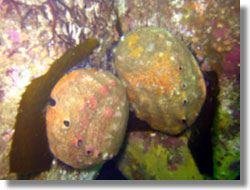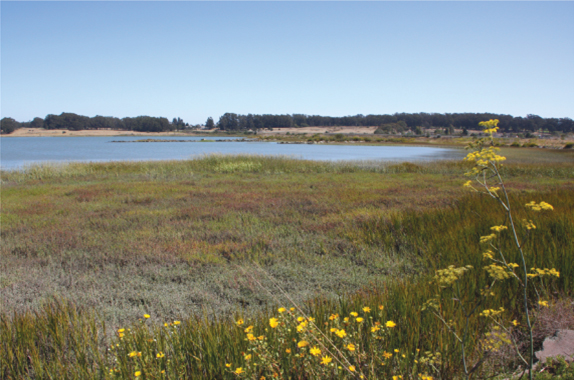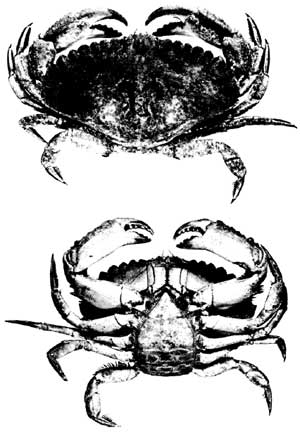Long Range Fish Report
From Sportfishing
From Sportfishing
Fish Report for 2-25-2014

FAQs: New Abalone Regulations for 2014
2-25-2014
California Department of Fish & Wildlife
FOR IMMEDIATE RELEASE - February 25, 2014
Why were regulation changes made for 2014?
The regulations were changed because dive surveys conducted by CDFW found abalone densities had dropped below trigger levels in the CDFW Abalone Recovery and Management Plan (ARMP). ARMP guidelines call for a reduction in catch if the average density of abalone at eight index sites in Sonoma and Mendocino counties falls below one-half abalone per square meter. The ARMP also mandates closure of individual sites which have fallen below one-quarter abalone per square meter. Abalone densities declined dramatically in Sonoma County due to fishing pressure and a harmful algal bloom which resulted in a large die-off of abalone at the end of August 2011. In 2012, average abalone density across index sites was below one-half abalone per square meter, and density at Fort Ross was below one-quarter abalone per square meter (see the 2012 fishery status update). On June 26, 2013, the Fish and Game Commission (FGC) decided to reduce the abalone catch according to ARMP guidelines and close the Fort Ross area. Details are available on the FGC website.
What is the reason the start time was changed to 8:00 a.m.?
The 8:00 a.m. start time reduces the number of low-tide days people will be able to take abalone by rock picking (searching amongst rocks for abalone at low tide); a number of low tides in the spring are much earlier than 8:00 a.m. This regulation change originated from the concerns of wardens who were witnessing large numbers of fishermen coming each and every low tide and taking large numbers of abalone. People were removing numerous undersized abalone while trying to find legal ones. Because undersized abalone often do not survive being removed and returned, they are likely to die and the impact on the fishery is probably much greater than the estimated legal catch (over 200,000 abalone annually in recent years). Some people were also using the dim light before dawn to hide illegal activities. Wardens believe a later start time will ease their biggest concerns and the FGC decided to choose that option.
Does the new rule mean that divers cannot enter the water prior to 8 a.m. if they plan to take abalone?
The new 8 a.m. start rule means divers cannot enter the water with the implements to take abalone and start searching for or taking abalone before 8 a.m. They can enter the water early and wait without searching for or taking abalone until 8 a.m. For example, if it takes a diver 30 minutes to swim to a dive spot, he or she could enter the water with the implements to take abalone, swim to the dive site and wait until 8 a.m. before searching for or taking abalone. Rock pickers have similar restrictions; they can walk to the spot before 8:00 a.m. but they cannot search for or take abalone before 8:00 a.m.
Can divers go spear fishing at the normal legal start time or take early morning photos, then switch over to abalone diving at 8 a.m.?
Yes, as long as they don't have the means of taking abalone or are searching for abalone before 8 a.m.If their activities appear to a warden to be taking or searching for abalone before 8 a.m., they could be cited.
Will the 8 a.m. start time prevent rock pickers from getting any abalone?
No, but the actual effect will vary each year because the timing of the tides changes each year. A number of good low tides will be too early in the morning to be useful for rock pickers but there will still be some good opportunities. For example, in 2014 there are several days with tides below -1.0 ft. after 8:00 a.m. in May and June.
Why was the annual limit lowered to 18?
The lower annual limit was combined with the 8:00 a.m. start time by the FGC in order to reduce the abalone take to levels prescribed in the ARMP. Since the increased restrictions in Sonoma and Marin counties will likely cause a shift in fishing effort to Mendocino County, the lower annual limit will also help keep the overall catch from increasing in Mendocino County.
Why are the annual limits lower in Sonoma and Marin counties?
Sonoma County sites that have been surveyed over the years have shown a greater decline in abalone density than Mendocino County sites.Lower annual limits were implemented for Sonoma and Marin counties to help prevent densities at those sites from further declines which could result in the sites being closed in the future. (for more information about the role density plays in abalone reproduction, see the new red abalone brochure).
How far north does the Sonoma-Marin annual limit of 9 abalone apply?
The Sonoma-Marin annual limit boundary is the Gualala River, located between the community of Sea Ranch to the south (Sonoma County) and the town of Gualala to the north (Mendocino County).
How will the Sonoma-Marin annual limit of 9 abalone be enforced?
The site codes used on previous versions of the abalone report card have been modified by adding a letter before the code numbers. All site codes within Sonoma and Marin counties now begin with the letter "S" and site codes within Mendocino, Humboldt, and Del Norte counties begin with the letter "N". Fishermen are required to include the "S" or "N" along with the number when recording the location code. An report card can have a mixture of "N" and "S" site codes as long as there are no more than 9 "S" codes and the total take does not exceed 18 abalone, the total number allowed per card starting in 2014.
I was not aware of abalone regulation changes for 2014 until recently. How can I be notified in advance of possible regulation changes in the future?
Contact the Fish and Game Commission to request to be put on the list to receive regulation notices for abalone.
These FAQs are available in printer friendly format and on the CDFW Marine Region FAQ page (click on 'Red Abalone').
CDFW Marine Management News
Ocean-related news and information
Visit the Marine Region Website at www.dfg.ca.gov/marine
California Department of Fish and Wildlife
Marine Region
20 Lower Ragsdale Dr. Suite 100
Monterey, CA, CA 93940
FAQs: New Abalone Regulations for 2014
Why were regulation changes made for 2014?
The regulations were changed because dive surveys conducted by CDFW found abalone densities had dropped below trigger levels in the CDFW Abalone Recovery and Management Plan (ARMP). ARMP guidelines call for a reduction in catch if the average density of abalone at eight index sites in Sonoma and Mendocino counties falls below one-half abalone per square meter. The ARMP also mandates closure of individual sites which have fallen below one-quarter abalone per square meter. Abalone densities declined dramatically in Sonoma County due to fishing pressure and a harmful algal bloom which resulted in a large die-off of abalone at the end of August 2011. In 2012, average abalone density across index sites was below one-half abalone per square meter, and density at Fort Ross was below one-quarter abalone per square meter (see the 2012 fishery status update). On June 26, 2013, the Fish and Game Commission (FGC) decided to reduce the abalone catch according to ARMP guidelines and close the Fort Ross area. Details are available on the FGC website.
What is the reason the start time was changed to 8:00 a.m.?
The 8:00 a.m. start time reduces the number of low-tide days people will be able to take abalone by rock picking (searching amongst rocks for abalone at low tide); a number of low tides in the spring are much earlier than 8:00 a.m. This regulation change originated from the concerns of wardens who were witnessing large numbers of fishermen coming each and every low tide and taking large numbers of abalone. People were removing numerous undersized abalone while trying to find legal ones. Because undersized abalone often do not survive being removed and returned, they are likely to die and the impact on the fishery is probably much greater than the estimated legal catch (over 200,000 abalone annually in recent years). Some people were also using the dim light before dawn to hide illegal activities. Wardens believe a later start time will ease their biggest concerns and the FGC decided to choose that option.
Does the new rule mean that divers cannot enter the water prior to 8 a.m. if they plan to take abalone?
The new 8 a.m. start rule means divers cannot enter the water with the implements to take abalone and start searching for or taking abalone before 8 a.m. They can enter the water early and wait without searching for or taking abalone until 8 a.m. For example, if it takes a diver 30 minutes to swim to a dive spot, he or she could enter the water with the implements to take abalone, swim to the dive site and wait until 8 a.m. before searching for or taking abalone. Rock pickers have similar restrictions; they can walk to the spot before 8:00 a.m. but they cannot search for or take abalone before 8:00 a.m.
Can divers go spear fishing at the normal legal start time or take early morning photos, then switch over to abalone diving at 8 a.m.?
Yes, as long as they don't have the means of taking abalone or are searching for abalone before 8 a.m.If their activities appear to a warden to be taking or searching for abalone before 8 a.m., they could be cited.
Will the 8 a.m. start time prevent rock pickers from getting any abalone?
No, but the actual effect will vary each year because the timing of the tides changes each year. A number of good low tides will be too early in the morning to be useful for rock pickers but there will still be some good opportunities. For example, in 2014 there are several days with tides below -1.0 ft. after 8:00 a.m. in May and June.
Why was the annual limit lowered to 18?
The lower annual limit was combined with the 8:00 a.m. start time by the FGC in order to reduce the abalone take to levels prescribed in the ARMP. Since the increased restrictions in Sonoma and Marin counties will likely cause a shift in fishing effort to Mendocino County, the lower annual limit will also help keep the overall catch from increasing in Mendocino County.
Why are the annual limits lower in Sonoma and Marin counties?
Sonoma County sites that have been surveyed over the years have shown a greater decline in abalone density than Mendocino County sites.Lower annual limits were implemented for Sonoma and Marin counties to help prevent densities at those sites from further declines which could result in the sites being closed in the future. (for more information about the role density plays in abalone reproduction, see the new red abalone brochure).
How far north does the Sonoma-Marin annual limit of 9 abalone apply?
The Sonoma-Marin annual limit boundary is the Gualala River, located between the community of Sea Ranch to the south (Sonoma County) and the town of Gualala to the north (Mendocino County).
How will the Sonoma-Marin annual limit of 9 abalone be enforced?
The site codes used on previous versions of the abalone report card have been modified by adding a letter before the code numbers. All site codes within Sonoma and Marin counties now begin with the letter "S" and site codes within Mendocino, Humboldt, and Del Norte counties begin with the letter "N". Fishermen are required to include the "S" or "N" along with the number when recording the location code. An report card can have a mixture of "N" and "S" site codes as long as there are no more than 9 "S" codes and the total take does not exceed 18 abalone, the total number allowed per card starting in 2014.
I was not aware of abalone regulation changes for 2014 until recently. How can I be notified in advance of possible regulation changes in the future?
Contact the Fish and Game Commission to request to be put on the list to receive regulation notices for abalone.
These FAQs are available in printer friendly format and on the CDFW Marine Region FAQ page (click on 'Red Abalone').
CDFW Marine Management News
Ocean-related news and information
Visit the Marine Region Website at www.dfg.ca.gov/marine
< Previous Report Next Report >
More Reports
California Department of Fish & Wildlife Reports
for Friday, February 21st, 2014
• Emergency Regulations to Close Angling Now In Effect
• Wildlife Conservation Board Funds Environmental Improvement and Acquisitions Projects

2-20-2014
California Department of Fish & Wildlife Marine Management News NEWS RELEASE FOR IMMEDIATE RELEASE - February 20, 2014 California Outdoors Q & A: Taking...... Read More

LongRangeSportfishing.net © 2025. All Rights Reserved.
Website Hosting and Design provided by TECK.net
Website Hosting and Design provided by TECK.net